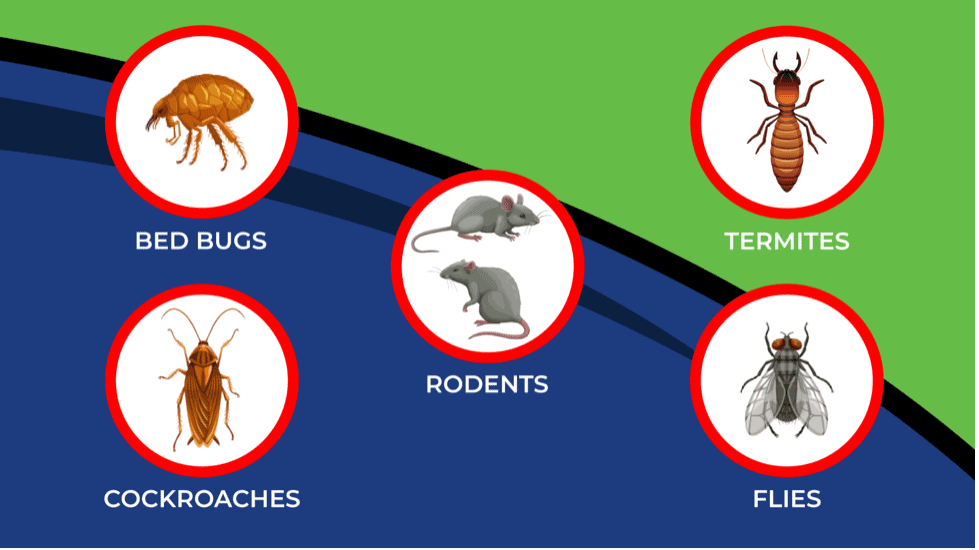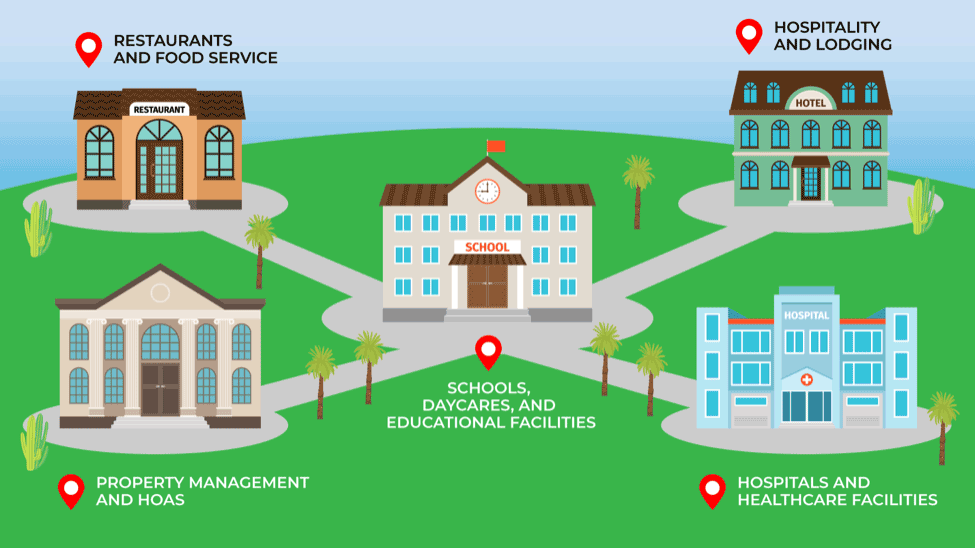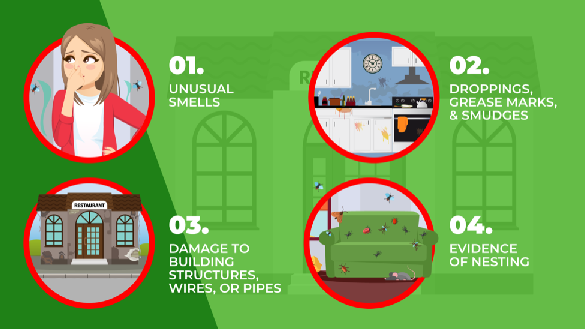If you’ve ever wondered whether you need pest control for your business, then there’s a good chance the answer is “yes.” Although the risk of a serious pest infestation varies by commercial industry, as a business owner, it’s important to have a game plan that’s proactive toward keeping insects, vermin, and other unwelcome pest patrons out of your building. Running your company successfully requires happy customers, healthy employees, and competitive pricing paired with profit.
From posing health hazards to causing severe structural and financial damage, a pest presence in your place of business is more than just a nuisance. Let the Arizona pest control experts at Burns Pest Elimination explain all you need to know about commercial pest removal and prevention.
5 Common Types of Pests That Invade Arizona Businesses

Bed Bugs
As keen hitchhikers, biting bed bugs are great at making their way inside undetected via luggage, clothing, old furniture, and more. If you run a hotel or resort in Arizona, a tourist hotspot, you know that busy lodging locations can also be a hotspot for bed bugs. Unfortunately, sometimes even the cleanest spaces can become a breeding ground for bed bugs to multiply—and nothing will drive a customer away quicker than waking up to red bite marks on their body.
Cockroaches
Cockroaches are one of the most hated insect pests, and for good reason: They’re nearly impossible to kill with traditional pest control methods, and they’ll eat just about anything that’s lying around. A nightmare for restaurant owners in particular, roaches can infest and contaminate all types of foods along with food prep surfaces and dishware.
Flies
Another type of insect customers don’t want to see is those of the flying variety. Managing fly populations inside your business is key to avoiding the spread of bacteria that flies can carry (or a” fly-in-the-soup” incident that leads to a bad review of your restaurant).
Rodents
When rodents invade commercial buildings, they may come into contact with merchandise or stored food products as they seek out food and a comfortable place to nest. Rats and mice are vectors for disease and present public safety concerns when they leave behind urine and feces, thus placing unwanted liability on business establishments without proper rodent control measures.
Termites
Termites are a pest that don’t seem all that scary—until the moment you fear you might have an infestation. That’s because these sneaky and strategic wood-destroying organisms can burrow deep into a building’s structure, eating away at its integrity until you’re suddenly left with costly repairs to make.
Top Commercial Industries That Benefit from Pest Control

Restaurants and Food Service
As we’ve mentioned, any food service establishment or food processing facility is going to attract pests aplenty. Bugs like ants and cockroaches, birds like pigeons, rodents like rats and mice, and even outdoor wildlife won’t hesitate to invade kitchens, break rooms, food storage rooms, trash areas, and any other place that provides a food source.
The simple sight of a pest in your restaurant (not to mention the food itself!) can not only spoil a customer’s dining experience; it may also lead to you losing business or receiving a negative review and a ding to your reputation. Plus, passing a health inspection with a pest infestation isn’t very feasible. In the worst-case scenarios, visitors and staff could contract various illnesses from critters such as rodents and roaches.
Hospitality and Lodging
Hotels, motels, resorts, and other hospitality businesses that manage temporary lodging sites can be inviting to guests that aren’t always human. Even the smallest inconveniences can turn customers away, however, so it’s crucial to be sure that pests aren’t one of them. In a competitive market, hotels and motels rely on positive reviews to earn customers’ business when they’re choosing the best place to stay.
The downside of having so many traveling guests staying in a concentrated area is that you don’t know what they’re bringing in with them. That’s why bed bug infestations can spread so rapidly and become an urgent matter within a few days. Finding efficient, expert help with eradication is essential in these situations.
Property Management and HOAs
Houses, condos, apartments, multi-family housing, and rental properties often offer pests ample access to food, water, harborage, and shelter. Bugs and rodents can enter, live inside, and even travel between the walls of multi-unit buildings. Nuisance bird populations may perch on wires, gutters, rooflines, and ledges. Flies and stinging insects make homes in yards and landscaping, while spiders will come to capture them as prey.
With residents and renters living close together in a community, pest problems can be prevalent and large-scale if not handled properly. Prevent tenant turnover and preserve your reputation with the help of a dependable pest control company.
Hospitals, Healthcare Facilities, and Medical Buildings
From hospitals to doctors’ offices to senior care or assisted living facilities, medical buildings and healthcare establishments encounter eager and hungry pests like disease-ridden mice, rats, and cockroaches. These types of rodents and insects can spread dangerous illnesses such as plague and salmonellosis—landing them last on the list of creatures you want around your patients and employees.
Schools, Daycares, and Educational Facilities
Working around children demands another level of caution when it comes to their safety and wellbeing. Aside from the disease-spreading bacteria some pests can pass on, others pose health concerns if they bite or sting. No matter if it’s an allergic reaction from a bee sting or an asthma attack due to residue from roaches or rodents, a pest harming a student or young kid should be prevented with proactive pest control for school buildings.
Why Is Regular Commercial Pest Control Important?
Operating a business wouldn’t be possible without the regular maintenance and upkeep that goes into it. That means protecting and investing in your employees, your customers, and the soundness of your building itself. Here’s how commercial pest control helps support businesses:
Upholding Industry Health and Safety Standards
Establishments that serve the general public must pass certain health inspections as well as meet safety standards to ensure the building is up to code. With pests present, there’s an increased risk of disease transmission to staff and customers from bacteria and viruses. Whether it’s a sick employee or a poor health inspection score aired on the local news, businesses might need time to bounce back from a pest infestation.
Preserving Brand Reputations
With online reviews and social media being the main sources of business information and customer opinions, news can travel far and wide (and fast). Before a commercial pest invasion multiplies into a full-blown infestation, it’s important to nip it in the bud. Risking your hard-earned reputation being tarnished permanently because of unpleasant pests simply isn’t worth it.
Preventing Financial Costs and Damages
A reactive approach to pest control can disrupt business in addition to your bottom line. In the United States, commercial pest infestations contribute to billions of dollars of lost revenue each year. If you decide to purchase a commercial property, overlooking a pest infestation can be expensive when the problem is left in your hands. Product pests perusing your inventory and food supply can create headaches with burdensome bills to replace contaminated products. If customers become sick from contaminated food, you could even get into legal trouble.
What Are the Signs of a Commercial Pest Infestation?
We’ve emphasized the risks of ignoring a pest infestation, but what about the warning signs? These are some ways to recognize a potential pest problem for early detection:

Foul or Unusual Smells
If you think you smell rotting food or dead pests, it’s possible your business has an infestation. Additionally, rodent and insect droppings can produce foul smells from within your walls and other hard-to-reach areas like under and behind appliances.
Droppings, Grease Marks, and Smudges
Because pest droppings are a telltale sign of their presence, look for dark-colored fecal matter left behind. Some may look like dirt, mud, or coffee grounds at first, so don’t dismiss these droppings as something else if you suspect an infestation. Insects may also leave wings or shed exoskeletons, while rodents such as rats leave traces of fur, body grease, or pieces of trash they got into. Dirt, grime, and grease tracks are all major signals of a rodent problem. In particular, rats and mice will follow the same route along walls each time they come out of their nest to scrounge for food, causing visible grease spots along the wall in their tracks.
Damage to Building Structures, Wires, or Pipes
Termites and rodents are pests that usually do the most noticeable destruction to commercial buildings. As avid chewers, mice and rats can gnaw through pipes, electrical wiring, and gas lines, so noticing any leaking pipes or frayed wires may point to a pest perpetrator. You’ll also want to look for damage and bite marks on low surfaces, such as cabinets and baseboards.
Let Our Business Protect Yours with Commercial Pest Control
No matter if you run a family restaurant in Phoenix, a popular nightclub in Las Vegas, NV, or a luxury hotel in Scottsdale, AZ, it’s never safe to assume that your business is safe from a commercial pest infestation. Fortunately, Burns Pest Elimination provides professional pest control backed by local expertise and decades of experience serving Arizona and Nevada. Think you need pest elimination help for your business?
Don’t overthink it: Call Burns to chat with our team, or request a free quote online today!
More From Burns Pest Elimination


